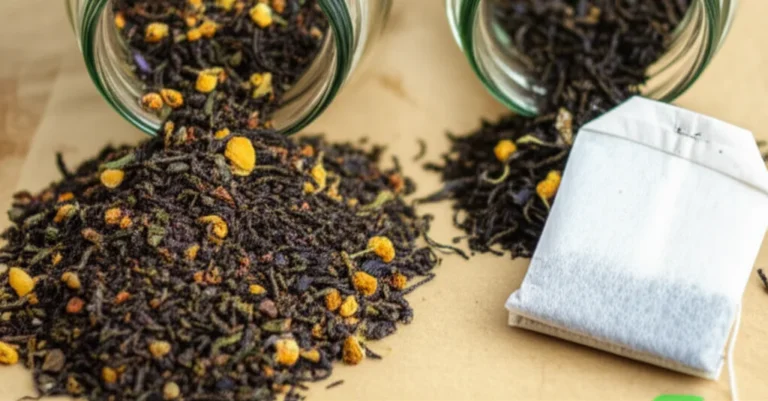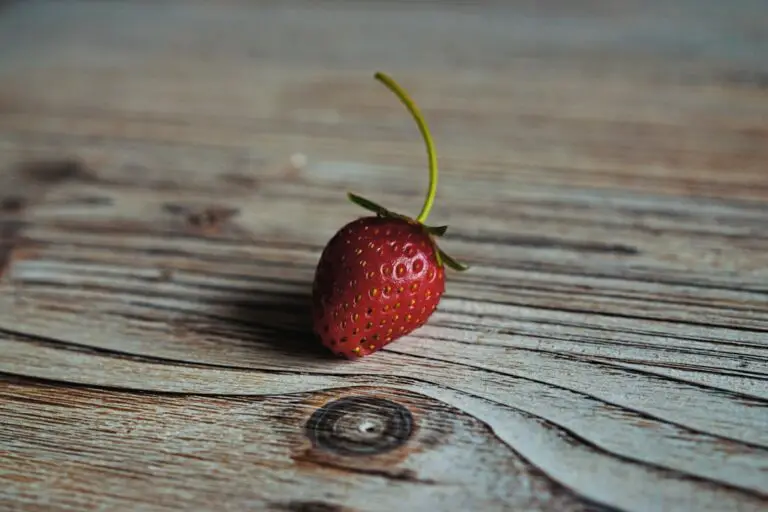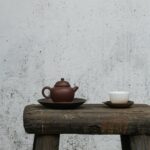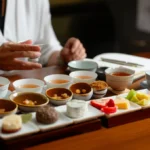Support our educational content for free when you purchase through links on our site. Learn more
How Do Tea Experts Evaluate the Flavor of Tea? ☕️ (2025)
Ever wondered how tea experts can distinguish a delicate floral note from a subtle astringency or why some teas leave a lingering sweetness while others feel sharp and biting? At Tea Brands™, we’ve spent years honing our palates and mastering the art and science of tea flavor evaluation. This article peels back the curtain on the sensory secrets, tools, and techniques that professional tasters use to judge tea quality with pinpoint precision.
From the ancient rituals of Gongfu Cha to cutting-edge scientific studies on polyphenols and fixation methods, we’ll guide you through every step of the tasting journey. Curious why two green teas from different regions taste worlds apart? Or how a simple “slurp” can unlock hidden flavors? Stick around—we’ll share insider anecdotes, expert tips, and even a step-by-step cupping guide so you can taste like a pro at home.
Key Takeaways
- Tea flavor evaluation engages all five senses: sight, smell, taste, touch, and even sound.
- Consistent brewing parameters are essential for fair and accurate tasting.
- Astringency and bitterness are influenced by polyphenol content and processing techniques like fixation.
- The Tea Aroma Wheel and tasting lexicons help experts articulate complex flavor profiles.
- Professional cupping rituals provide a structured, repeatable method to assess tea quality.
- Terroir and processing methods dramatically shape flavor, making each tea unique.
- You can apply expert techniques at home to elevate your daily tea experience.
Ready to unlock the mysteries behind your next cup? Let’s dive in!
Table of Contents
- ⚡️ Quick Tips and Facts: Your Essential Tea Tasting Cheat Sheet!
- 📜 The Ancient Art & Modern Science of Tea Evaluation: A Journey Through Flavor History
- 🛠️ The Tea Taster’s Toolkit: Essential Gear & Environment for Precision Flavor Assessment
- 👃👅👁️ The Five Senses of Tea: How Experts Engage Sight, Smell, Taste, Touch, and Even Sound!
- 1. The Visual Feast: What a Tea’s Appearance & Leaf Grade Tell Us About Quality
- 2. The Olfactory Odyssey: Unlocking Tea’s Aromatic Secrets with a Tea Aroma Wheel
- 3. The Palate’s Playground: Decoding Tea’s Core Taste Components & Flavor Profiles
- 4. The Mouthfeel Marvel: Understanding Tea’s Texture, Body, and Lingering Sensations
- 5. The Echo of Flavor: The Elusive Aftertaste and Finish in Expert Tea Evaluation
- 🍵 The Ritual of Cupping: A Step-by-Step Guide to Professional Tea Tasting & Sensory Evaluation
- 🧠 Beyond the Basics: Advanced Concepts in Tea Flavor Evaluation & Quality Assessment
- ⚠️ Common Pitfalls & How to Avoid Them: Expert Advice for Aspiring Tea Tasters
- ☕ From Our Cupping Table to Your Cup: Real-World Anecdotes from Tea Brands™ Experts
- 🏡 Elevating Your Home Tea Experience: Applying Expert Sensory Evaluation Techniques to Your Daily Brew
- ✨ Demystifying Tea Grades & Quality: What Do Those Labels & Certifications Really Mean?
- 🌟 Conclusion: The Endless Journey of Tea Flavor Discovery & Appreciation
- 🔗 Recommended Links: Dive Deeper into the World of Tea Tasting & Education
- ❓ Frequently Asked Questions (FAQ): Your Burning Tea Flavor Queries Answered!
- 📚 Reference Links: Our Trusted Sources & Further Reading for Tea Enthusiasts
⚡️ Quick Tips and Facts: Your Essential Tea Tasting Cheat Sheet!
Welcome to the world of tea tasting, where every sip is a story and every aroma a secret waiting to be uncovered! At Tea Brands™, we’ve spent countless hours swirling, slurping, and savoring teas from around the globe. Here are some quick tips and fascinating facts to kickstart your journey into expert tea flavor evaluation:
- Use all five senses: Tea tasting isn’t just about taste. Sight, smell, touch, and even sound (yes, the slurp!) play crucial roles.
- Temperature matters: Brewing temperature and steeping time dramatically affect flavor extraction and balance.
- Leaf quality = flavor potential: Larger, whole leaves often yield more nuanced flavors than fannings or dust.
- Astringency is a key player: That dry, puckering sensation comes mainly from polyphenols like catechins and flavonoids.
- Slurping is not rude—it’s essential! It aerates the tea, spreading flavors across your palate.
- Tea aroma wheels help decode complex scents, from floral to roasted.
- Fixation process in green tea can make or break bitterness and astringency levels.
- Blending is an art: Experts evaluate how different teas harmonize to create balanced blends.
- Keep notes: Professional tasters use detailed forms to record every nuance.
Curious about how these tips translate into actual tasting? Hang tight—we’re diving deep into the science, art, and secrets of tea flavor evaluation next!
For a head start, check out our related article on What is the world’s best tasting tea?.
📜 The Ancient Art & Modern Science of Tea Evaluation: A Journey Through Flavor History

Tea tasting is an ancient ritual dating back thousands of years in China, evolving from a simple appreciation of aroma and taste into a sophisticated sensory science. The earliest tea masters relied on intuition and tradition, but today’s experts combine centuries-old wisdom with modern analytical techniques.
The Roots of Tea Tasting
- Chinese Tea Culture: The Gongfu Cha ceremony emphasizes mindful brewing and appreciation of subtle flavors.
- Japanese Influence: Matcha preparation and tasting focus on umami and mouthfeel.
- Western Adaptation: Inspired by wine sommeliers, tea sommeliers have formalized tasting protocols, emphasizing systematic evaluation.
Modern Scientific Advances
- Quantitative Descriptive Analysis (QDA): Used to measure flavor intensity and astringency, as detailed in recent studies like the one published by Nature Food.
- Metabolomics: Identifies chemical compounds responsible for taste and aroma.
- Sensory Lexicons: Standardized vocabularies help tasters communicate complex flavors clearly.
This blend of tradition and science allows tea experts to pinpoint exactly what makes a tea exceptional—or not. Ready to see what tools they use? Let’s peek into the tea taster’s toolkit next.
🛠️ The Tea Taster’s Toolkit: Essential Gear & Environment for Precision Flavor Assessment
Just like a painter needs brushes and canvas, tea tasters rely on specialized equipment and controlled environments to evaluate tea flavor accurately.
Essential Tools
| Tool | Purpose | Notes |
|---|---|---|
| International Standard Tea Evaluation Cup Set | For brewing and tasting standardized samples | Includes brewing cup, liquor bowl, and tasting spoon. Learn more |
| Tea Aroma Wheel | To identify and describe aroma notes | Developed by the Tea Association of the USA. |
| Cupping Bowls | Wide-mouthed bowls for steeping and slurping | Allows aroma to concentrate and easy tasting. |
| Precision Scale | Accurate measurement of tea leaves | Ensures consistency in brewing. |
| Thermometer | Controls water temperature | Critical for different tea types (green, black, oolong). |
| Timer | Tracks steeping duration | Prevents over- or under-extraction. |
Ideal Environment
- Neutral Smell: Avoid perfumes, food odors, or smoke.
- Quiet Space: Helps focus on subtle sensory cues.
- Good Lighting: To assess leaf and liquor color accurately.
- Clean Palate: Tasters often cleanse with water or plain crackers between samples.
At Tea Brands™, we swear by these tools and conditions to ensure every cup is judged fairly and expertly. Curious how the senses come into play? Let’s explore that next!
👃👅👁️ The Five Senses of Tea: How Experts Engage Sight, Smell, Taste, Touch, and Even Sound!
Tea tasting is a full sensory experience. Experts at Tea Brands™ engage all five senses to unlock the complete flavor profile.
1. The Visual Feast: What a Tea’s Appearance & Leaf Grade Tell Us About Quality
- Dry Leaf Inspection: Size, shape, color, and uniformity reveal processing quality. Whole leaves usually indicate higher quality.
- Infused Leaf: Post-brew, leaves show oxidation level and freshness.
- Liquor Color: Clear, bright liquor suggests good processing; dull or murky may indicate poor quality or oversteeping.
Example: In our recent tasting, a premium Darjeeling First Flush showed vibrant golden liquor and whole, twisted leaves—signs of careful plucking and processing.
2. The Olfactory Odyssey: Unlocking Tea’s Aromatic Secrets with a Tea Aroma Wheel
- Primary Aromas: Floral, fruity, vegetal, roasted, smoky, or earthy.
- Secondary Aromas: Develop during brewing and can hint at fermentation or roasting.
- Astringency-Linked Aromas: Some polyphenols contribute to astringent scents.
The Tea Aroma Wheel, developed by the Tea Association of the USA, helps tasters articulate these complex scents. We often use it during blind tastings to train our noses.
3. The Palate’s Playground: Decoding Tea’s Core Taste Components & Flavor Profiles
Tea flavor is a symphony of:
- Sweetness: Natural sugars and amino acids.
- Bitterness: Often from catechins and caffeine.
- Astringency: The puckering sensation caused by polyphenols like EGCG and rutin, as highlighted in the Nature Food study.
- Umami: Especially in green and matcha teas.
- Sourness: From organic acids.
Experts balance these tastes to judge harmony and complexity.
4. The Mouthfeel Marvel: Understanding Tea’s Texture, Body, and Lingering Sensations
- Body: Light, medium, or full-bodied.
- Texture: Smooth, creamy, or dry.
- Temperature Sensation: Warmth or coolness on the palate.
- Lingering Sensations: How long flavors and astringency remain (finish).
5. The Echo of Flavor: The Elusive Aftertaste and Finish in Expert Tea Evaluation
The finish is the final impression—a tea’s lasting memory. A clean, pleasant aftertaste is a hallmark of quality.
🍵 The Ritual of Cupping: A Step-by-Step Guide to Professional Tea Tasting & Sensory Evaluation
Cupping is the gold standard for professional tea evaluation. Here’s how Tea Brands™ experts approach it:
Step 1: Preparing the Tea Sample
- Weigh exactly 3 grams of dry tea leaves.
- Use freshly boiled water at the correct temperature (e.g., 80°C for green tea, 95°C for black tea).
- Steep for 3-5 minutes depending on tea type.
Step 2: Observing Dry Leaves
- Examine leaf size, shape, and aroma.
- Note any defects or inconsistencies.
Step 3: Brewing & Smelling
- Pour hot water over leaves.
- Immediately smell the wet leaves and the liquor to capture volatile aromas.
Step 4: Slurping & Tasting
- Slurp tea loudly to aerate and spread flavors.
- Evaluate sweetness, bitterness, astringency, umami, and mouthfeel.
- Compare taste to aroma notes.
Step 5: Inspecting Wet Leaves
- Examine color, texture, and integrity.
- Helps confirm processing quality.
Step 6: Recording Observations
- Use standardized forms with scoring for aroma, taste, mouthfeel, and appearance.
- Include descriptive notes.
This process is repeated for multiple samples, allowing for comparative analysis.
Brewing Parameters: The Foundation of Fair Tea Cupping & Consistent Flavor Assessment
Consistency is king! Variations in water temperature, leaf quantity, or steeping time can skew results.
| Tea Type | Water Temperature | Steeping Time | Leaf Quantity (g) |
|---|---|---|---|
| Green Tea | 75–85°C | 2–3 minutes | 3 |
| Black Tea | 90–100°C | 3–5 minutes | 3 |
| Oolong Tea | 85–95°C | 3–4 minutes | 3 |
| White Tea | 80–85°C | 4–5 minutes | 3 |
The Slurp & Swirl: Mastering the Expert Tea Tasting Technique for Full Flavor
Slurping might feel odd at first, but it’s essential:
- Aerates the tea, releasing volatile aromatics.
- Distributes liquid across the palate, engaging all taste buds.
- Helps detect subtle flavor notes and mouthfeel.
Our experts recommend practicing this in front of a mirror to perfect the technique!
The Tea Taster’s Lexicon: Speaking the Universal Language of Tea Flavor Descriptors
Communicating flavor is an art. Here are some common descriptors:
| Flavor Category | Descriptors |
|---|---|
| Aroma | Floral, fruity, grassy, roasted, smoky |
| Taste | Sweet, bitter, astringent, umami, sour |
| Mouthfeel | Smooth, creamy, dry, velvety |
| Aftertaste | Lingering, clean, bitter, mellow |
Using this lexicon helps tasters compare notes and maintain consistency globally.
🧠 Beyond the Basics: Advanced Concepts in Tea Flavor Evaluation & Quality Assessment
Ready to go deeper? Let’s explore how geography, processing, and blending influence tea flavor.
Terroir’s Tale: How Geographical Origin Shapes a Tea’s Unique Flavor Character
Just like wine, tea’s flavor is profoundly shaped by terroir—the combination of soil, climate, altitude, and local flora.
- Darjeeling teas often have muscatel notes due to Himalayan soils.
- Japanese teas like Gyokuro have a rich umami from shade-growing.
- Yunnan teas boast earthy, bold flavors from mineral-rich soil.
Terroir influences the chemical profile, including polyphenol and amino acid content, affecting bitterness and sweetness.
Processing Prowess: The Impact of Tea Crafting Methods on Flavor Development
Processing transforms fresh leaves into the teas we love:
| Processing Step | Effect on Flavor |
|---|---|
| Withering | Reduces moisture, concentrates sugars |
| Fixation (Green Tea) | Stops oxidation, preserves freshness |
| Rolling | Breaks leaves, releases enzymes |
| Oxidation | Develops color and flavor complexity |
| Firing/Drying | Locks in flavor, adds roasted notes |
The recent Nature Food study highlights how fixation temperature can reduce bitterness and astringency by altering polyphenol profiles.
The Art of Blending: How Experts Evaluate Teas for Harmonious & Consistent Blends
Blending is both science and art:
- Experts assess individual teas for complementary flavor profiles.
- Balance astringency, sweetness, and aroma.
- Ensure consistency across batches.
- Consider target consumer preferences.
At Tea Brands™, we’ve blended teas like Harney & Sons’ Hot Cinnamon Spice by carefully evaluating each component’s flavor contribution.
⚠️ Common Pitfalls & How to Avoid Them: Expert Advice for Aspiring Tea Tasters
Even seasoned tasters slip up! Here’s what to watch out for:
- Inconsistent brewing: Use precise measurements and timers.
- Ignoring environment: Avoid strong smells and distractions.
- Skipping palate cleansers: Water or plain crackers reset your taste buds.
- Over-relying on one sense: Engage all five senses for full evaluation.
- Bias toward price or brand: Taste objectively, blind when possible.
Our team once misjudged a tea’s quality due to oversteeping—lesson learned: timing is everything!
☕ From Our Cupping Table to Your Cup: Real-World Anecdotes from Tea Brands™ Experts
Let us share a story: During a recent tasting, we compared two green teas—one pan-fired from Zhejiang and one oven-fired from Anhui. The pan-fired tea had a delicate, nutty aroma but a sharp astringency. The oven-fired was more balanced with a smooth mouthfeel. Using insights from the Nature Food study, we realized the fixation method was the key difference affecting astringency.
Another time, we tested black teas in sachets vs. traditional tea bags, echoing the insights from the featured video. The sachet tea consistently scored higher for leaf quality and flavor complexity.
These experiences show how expert evaluation translates into better tea choices for you!
🏡 Elevating Your Home Tea Experience: Applying Expert Sensory Evaluation Techniques to Your Daily Brew
You don’t need a professional setup to taste like an expert! Here’s how to bring tea tasting home:
- Use filtered water and control temperature with a kitchen thermometer.
- Measure tea leaves with a digital scale.
- Observe dry leaves for size and aroma.
- Smell the brewed tea before tasting.
- Slurp to aerate and spread flavors.
- Take notes in a journal or app.
- Try blind tastings with friends to sharpen your palate.
By practicing these techniques, you’ll appreciate nuances and discover your favorite teas with confidence.
✨ Demystifying Tea Grades & Quality: What Do Those Labels & Certifications Really Mean?
Tea grading can be confusing. Here’s a quick guide:
| Grade Label | Meaning | Example Brands |
|---|---|---|
| Whole Leaf | Intact leaves, highest quality | Harney & Sons, Rishi Tea |
| Broken Leaf | Smaller pieces, good flavor but less complex | Twinings, Stash |
| Fannings | Tiny leaf fragments, quick brew, less flavor | Most tea bags |
| Dust | Powdered leaf, strong but flat flavor | Bulk tea bags |
| Organic Certification | Grown without synthetic pesticides | Numi Organic Tea, Traditional Medicinals |
| Fair Trade | Ethical sourcing and fair wages | Equal Exchange, Choice Organic |
Remember, grade influences flavor potential but not always enjoyment. Some prefer brisk fannings for quick, strong cups.
🌟 Conclusion: The Endless Journey of Tea Flavor Discovery & Appreciation

So, how do tea experts evaluate the flavor of tea? It’s a complex dance of science, tradition, and sensory mastery. From the moment dry leaves meet hot water, every step—from visual inspection to the final lingering aftertaste—is a clue in the grand puzzle of tea quality. Our journey through the five senses, the ritual of cupping, and the nuanced chemistry behind astringency and aroma shows that tea tasting is far more than a casual sip. It’s an art form and a science, honed by experience and sharpened by knowledge.
We’ve also seen how fixation temperature and processing methods can dramatically alter bitterness and astringency, as confirmed by cutting-edge research. This explains why two green teas from different regions or processing styles can taste worlds apart. The tea taster’s toolkit—from aroma wheels to precision scales—ensures that this evaluation is as objective and repeatable as possible.
For you, the tea lover, this means you can confidently explore teas with a sharper palate and a richer appreciation. Whether you’re brewing a delicate Gyokuro or a robust Assam, applying expert techniques will unlock hidden layers of flavor and elevate your daily cup.
Remember our earlier question: Why does one green tea taste smooth and another sharp? Now you know—it’s all in the fixation and polyphenol chemistry! So next time you sip, think like a tea sommelier and savor the story in your cup.
🔗 Recommended Links: Dive Deeper into the World of Tea Tasting & Education
Ready to explore or shop some of the teas and tools we’ve mentioned? Here are some top picks and educational resources:
-
Harney & Sons Hot Cinnamon Spice Tea:
Amazon | Harney & Sons Official Website -
Rishi Tea (Whole Leaf Green Teas):
Amazon | Rishi Tea Official Website -
Tea Aroma Wheel (Tea Association of the USA):
Tea Association of the USA -
International Standard Tea Evaluation Cup Set:
International Tea Academy -
Books on Tea Tasting & Sommelier Skills:
- The Tea Companion: A Connoisseur’s Guide by Jane Pettigrew — Amazon
- The Art and Craft of Tea: An Enthusiast’s Guide to Selecting, Brewing, and Serving Exquisite Tea by Joseph Uhl — Amazon
- Tea Sommelier Certification Study Guide by International Tea Academy — International Tea Academy
❓ Frequently Asked Questions (FAQ): Your Burning Tea Flavor Queries Answered!

What are the key steps in a professional tea tasting session?
Professional tea tasting, or cupping, follows a structured process:
- Dry Leaf Inspection: Observe leaf size, shape, and aroma to assess initial quality.
- Brewing: Use precise water temperature, leaf quantity, and steeping time to ensure consistency.
- Wet Leaf and Liquor Evaluation: Smell the brewed leaves and liquor immediately to capture aroma.
- Tasting: Slurp to aerate and spread flavors across the palate, noting sweetness, bitterness, astringency, umami, and mouthfeel.
- Aftertaste Assessment: Evaluate the finish and lingering sensations.
- Recording: Document all observations using standardized forms for comparison and quality control.
This methodical approach ensures objective and repeatable assessments, crucial for grading and purchasing decisions. For more, see the International Tea Academy’s guide.
Read more about “What Makes a Tea the Best Tasting in the World? 🍵 (2025)”
How do aroma and taste influence the quality assessment of tea?
Aroma and taste are the cornerstones of tea quality evaluation:
- Aroma provides the first sensory impression and reveals volatile compounds that indicate freshness, processing style, and terroir. For example, floral notes often suggest high-quality oolong or white teas, while roasted aromas indicate darker teas.
- Taste balances sweetness, bitterness, astringency, umami, and sourness. The harmony and complexity of these tastes determine the tea’s character and appeal.
- Astringency, caused by polyphenols like EGCG and rutin, is a critical factor—too much can be harsh, too little may lack structure.
- Experts use aroma wheels and lexicons to articulate these sensory details precisely.
Together, aroma and taste form a sensory fingerprint that distinguishes premium teas from mediocre ones.
Read more about “How to Choose the Best Tea Brand for Your Unique Taste 🍵 (2025)”
What tools do tea experts use to analyze tea flavor profiles?
Tea experts rely on a combination of traditional and modern tools:
- Standardized Tea Evaluation Cup Sets: For consistent brewing and tasting.
- Tea Aroma Wheels: To identify and describe complex aromas.
- Precision Scales and Thermometers: To control brewing variables.
- Cupping Bowls and Spoons: Facilitate aroma concentration and tasting.
- Sensory Lexicons and Scoring Sheets: For objective recording.
- Analytical Instruments (in labs): Such as metabolomics for chemical profiling.
These tools help tasters maintain objectivity and communicate findings clearly. See Tea Brands™ Toolkit for more.
How does water temperature affect the flavor evaluation of tea?
Water temperature is crucial because it controls the extraction of flavor compounds:
- Too hot: Extracts excessive bitterness and astringency, masking delicate flavors.
- Too cool: Under-extracts, resulting in weak, flat taste.
- Different teas require different temperatures:
- Green teas: 75–85°C to preserve freshness and umami.
- Black teas: 90–100°C to fully extract bold flavors.
- Oolong teas: 85–95°C for balanced extraction.
Precise temperature control ensures tasters evaluate the tea’s true flavor potential, not artifacts of brewing errors.
Read more about “17 Affordable Quality Tea Brands You’ll Love in 2025 🍵”
Additional FAQs
What is the role of fixation in green tea flavor?
Fixation halts enzymatic oxidation, preserving green tea’s fresh character. The Nature Food study shows that fixation temperature and method significantly influence bitterness and astringency by altering polyphenol content.
How do tea sommeliers differ from casual tea drinkers?
Tea sommeliers possess formal training in sensory evaluation, tea production, and cultural knowledge. They use standardized methods to assess quality objectively, whereas casual drinkers rely on personal preference.
Read more about “Which Tea Has the Most Benefits? ☕️ Discover the Top 10 in 2025”
📚 Reference Links: Our Trusted Sources & Further Reading for Tea Enthusiasts
- Nature Food: Fixation and Astringency in Green Tea
- International Tea Academy: What is Tea Sommelier?
- Tea Association of the USA: Tea Aroma Wheel
- Harney & Sons Official Website
- Rishi Tea Official Website
- Tea Brands™ Tea Brand Guides
- Tea Brands™ Health Benefits of Tea
Explore these to deepen your tea knowledge and tasting skills!





